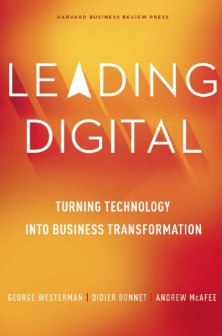Leading Digital (Turning Technology into Business Transformation) by George Westerman, Didier Bonnet and Andrew McAfee (Harvard Business Review Press). A ripping yarn summarised by Neil Rainey.
INSIDE THIS SUMMARY:
Summary of the Summary
1 Why Bother with Digital?
2 Build your Digital Capabilities.
3 Build your Leadership capabilities.
4 How to implement Digital Transformation
Summary of the Summary
1. Social Media, mobile computing, analytics, the smart phone, tablets, Cloud computing. The shifts in technology are massive and all are enablers for a revolution impacting business right now.
2. Digital transformation needs us all to think seriously about how we can become a master of digitisation rather than a victim.
3. Digital Masters use technology to increase profitability. They are good at it, making 26% more profit than their non-Digital savvy peers. Digital Mastery is about using digital technology to create a market or drive efficiency.
4. 90%+ of organisations don’t deliver technology for a living. That does not mean that you cannot carve out competitive advantage by making the most of technology shifts going on around you.
5. Anyone can buy new tools. Digital mastery comes from conceptualising possibility and executing brilliantly. The Digital tools are the “What” and the execution with great Leadership capabilities is the “How”.
6. Build your Digital Capabilities: – Transforming the customer experience is the centre of digital transformation. Making the most of the power of your core operations can set you apart.
7. Standardisation makes automation possible. Automation, the digitisation of roles, frees up people for the things humans are good at, it doesn’t just lay them off.
8. Control reduces process variation. It does NOT reduce the ability of the human factor in changing the way things are done.
9. Digital technologies are unleashing people from where and when they work. Increasingly work is a thing you do rather than a place you go. Digital technology empowers, it is an opportunity.
10. New competitors will attack your market share from completely new angles. You can hit back hard; reinvent your industry, substitute products and services, create new digital businesses, reconfigure your value delivery model, rethink your value propositions.
11. Build your Leadership Capabilities – craft the Digital Vision for your organisation, frame the Vision, define a clear outcome and intent and then engage the organisation at scale, build a governance model that suits your organisation.
12. If your relationship with the IT group doesn’t work: – then something needs to change and fast. The IT – Business relationship must be strong to drive digital transformation. Just moaning about it will just carve out market share for competitors.
13. To implementing Digital Transformation Frame the Digital Challenge, Focus investment, mobilise the organisation and then sustain the transition. Sustain the Transformation:
14. Transformations fail because change fatigue sets in, unaligned metrics and KPI’s get in the way and it just seems exhausting and hard work. It is easy to slip back to the old ways of doing things.
15. To sustain transformation do 3 things; build foundation capabilities, align incentives and rewards and measure, monitor and have continual review in place.
1) Why bother with Digital?
The shift is happening now Globalisation, shifting value pools, changing demographics are all major and important drivers of change. Bigger are the shifts happening in technology: – the Social Media explosion, mobile computing, and analytics, the rise of the smart phone and tablet, the emergence of Cloud networking and computing. The shifts in technology are massive. And it does not stop: – robotics (pervasive, not just in factories), machine learning, artificial intelligence, the Internet of Things, selfdriving vehicles, the list goes on. All of these technologies are digital and all are enablers for a revolution in the way business is done.
Mastery or Victim? Digital transformation needs us all to think seriously about how we can become a master of digitisation rather than a victim. Victim stories abound from print media to film, organisations that just did not make the move and finished up. Digital Masters use technology to increase profitability and as this book will show, they succeed at it, making 26% more profit than their non-Digital Master peers.
More than 90% of companies do not do Technology for a living but that does not mean they cannot carve out a competitive advantage by making the most of the technology shifts going on around them. Defining Digital Mastery Digital Mastery is using digital technology to create a market or drive efficiency.
- New Market – Nike created a world of customer stickiness by mashing data collection via the Fuel Band device worn by its customers with social media. This created a whole community for athletes to track and share performance and socialise.
- Efficiency – many examples of efficiencies in plants, supply chains and processes attained by harnessing digital technology. New toys vs Mastery Anyone can buy new tools. Digital mastery comes from conceptualising possibility and executing brilliantly. The Digital tools are the “What” and the execution with great Leadership capabilities is the “How”. By creating a matrix of Digital capability vs Leadership capability we can see archetype organisations.
Free chapter download here
Article by channel:
Everything you need to know about Digital Transformation
The best articles, news and events direct to your inbox
Read more articles tagged:







